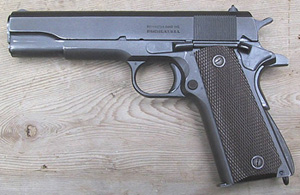

Q: I'd like some information on a Colt 25 pistol. Identification & Values." Retrieved from
#Remington rand 1911a1 hoster 1943 free#
MLA style: "Identification & Values." The Free Library.The Remington Rand in the Vault came from its owner complete with its 1943-marked Boyt M3 shoulder holster. Air Force Museum has an example of one such gun on display carried by a WWII B-17 gunner that caught a piece of German flak on a mission. While Navy aviators had to make do with various revolvers, Army Air Force aircrew were typically issued standard M1911A1s. While aircrew were limited as to what they could bring along on their high altitude flights - for instance, most liquids were banned due to the likelihood of them freezing in the unpressurized aircraft - they were issued basic survival gear such as a special extreme cold-weather uniform, life vest, parachute and a pistol in case they had to “hit the silk” and try to escape and evade Axis patrols to make it to friendly lines, often with the help of local resistance groups. Over the course of the war, the 8th Air Force alone lost a staggering 4,145 bombers on missions over Europe. By Mission # 817 in February 1945, the 8th Air Force was putting an amazing 1,437 bombers into the air over Berlin. While that initial raid only fielded 18 B-17 bombers on a strike in occupied France, by Mission # 84, the famed Schweinfurt–Regensburg Raid - which was 76 years ago this week and coincides to the “born on” date of our Remington-Rand - the 8th Air Force sent 376 B-17s deep into Germany itself. VIII Bomber Command, the England-based unit that was to grow into the mighty 8th Air Force. This week marks the 77th anniversary of Mission #1, the first heavy bomber attack on Nazi-occupied Europe by the U.S. At 25,000 feet, the temperature could drop below -60 degrees Fahrenheit but the Germans had their own way to keep things very hot for American aircrews. Army Air Force B-17 bombers flying through flak on their way to a target in Europe. Atwood, an Ordnance Department wheel, and U.S.
#Remington rand 1911a1 hoster 1943 serial number#
With a serial number that dates to 1943, the Remington Rand in the Vault has what collectors consider Type 3 slide markings, a very crisp “FJA” Ordnance inspector’s mark of Col. Switch & Signal, and even the Singer Sewing Machine company would produce over 1.8 million of these iconic handguns during the conflict, it was Remington Rand that delivered the most to Uncle Sam.

While Colt, Ithaca, railway equipment maker U.S. The company received drawings, gauges and tooling from the Army’s Springfield Armory, which had been previously used to manufacture M1911s and converted their “C” Division typewriter plant and warehouse in 1942 to war production. However, as with other gadget and widget makers, during WWII they retooled to help crank out the Arsenal of Democracy and win the war.įor Remington Rand, this meant making M1911A1 pistols, the standard U.S. Remington Rand, not to be confused with Remington Arms, was a business machine company formed in a merger between the Remington Typewriter Company and Rand Kardex Corporation during the Roaring Twenties.

45 certainly has a lot to say just by looking at it. While the golden rule in used firearms is “buy the gun, not the story,” this Government Issue. The gun came to us from the family of a man who was reportedly a B-17 bomber pilot during the conflict. One of the more interesting guns that have come through the Vault in recent months is a World War II-era Remington Rand M1911A1. This 1943 Remington Rand M1911A1 is striking.


 0 kommentar(er)
0 kommentar(er)
